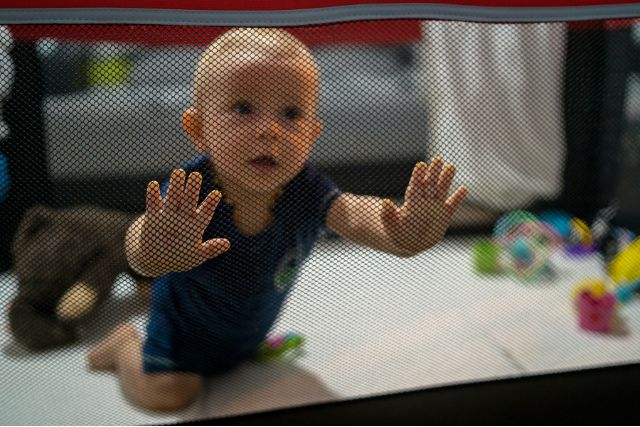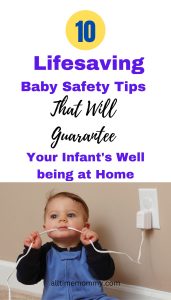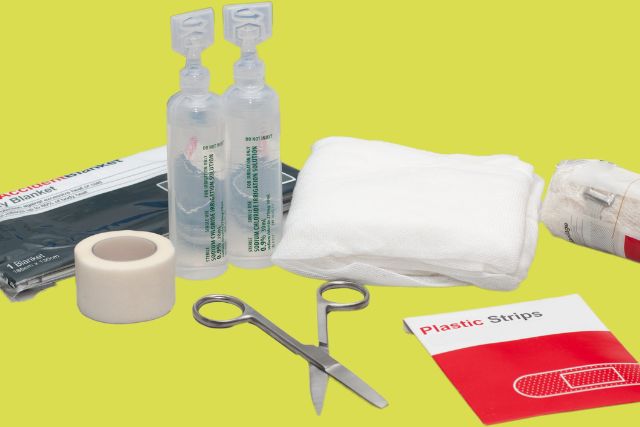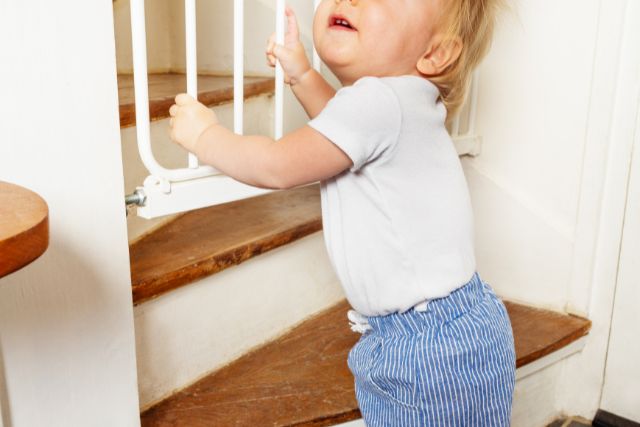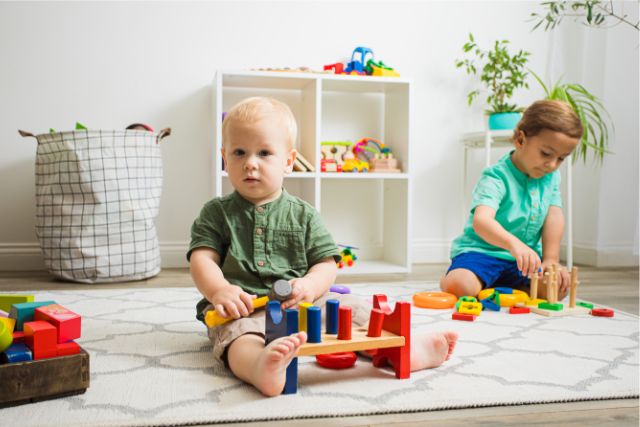They say we talk too much about baby safety tips at home.
Buuut…
Have you ever heard dreadful stories about baby accidents at home?
Well,
I have not just heard about these stories but rather experienced one of the terrific accidents that can happen around a mother.
My second born rolled over the balcony grills and fell from a storey building. Yes. It happened in our resident house.
Had it not been for God’s saving grace, I would be telling a different story.
Smashing his young head on the cemented ground resulted in a flat head with partial compression on the brain and a crack in his skull. Luckily there was no bleeding in the brain, and he survived.
If you’re wondering how his doing, don’t worry; his fine.
Mama,
Accidents happen around households.
And while some may result in minor injuries, others can be frightful, heart wrecking, and fatal.
Talk of burns, falls, suffocation, and even Choking from food, buttons, or toys.
Yes.
All these life-threatening things do happen right under our roofs. And if you think I’m exaggerating, ask any pediatricians.
They will confirm that there are many accidents kids suffer at home, including;
- Falling and tripping from furniture, beds, changing tables, or stairs which may result to broken limbs, teeth, backbones, and head injuries.
- Burns and scald from pulling off hot pans from stoves and testing hot things.
- Choking: Babies love picking and putting tiny items into their mouths. Usually, those things may result in choking. Even during meals, some of the foods can choke your baby.
- Liquitab Poisoning from consuming cleaning detergents and harmful products in our unsecured cabinets.
- Drowning in home bathtubs is common. Just looking away for a minute or two while grabbing a towel from a nearby closet or going to answer an agent door alarm may turn a happy moment into an emergency.
- Furniture tipping over; kids love swinging and balancing to wall units, bookshelves, and dressers, especially when learning to walk. But if those pieces aren’t anchored to the wall, they can tip over on children and cause serious injuries or death.
- Suffocating during sleep from Unsafe sleeping conditions like putting toys and pillows in a crib.
- Electrocution due to accessible sockets and unsecured electrical cables.
- Strangulation by Blind Cords: according to a pediatric Journal, Injuries Related to Window Blinds, Shades, and Cords are many. From 1990 to 2015, there were an estimated 16 827 window blind–related injuries among children younger than 6 years of age.
- Dog Bites or cat scratches
According to the C D C, child injury is a common phenomenon all over the world.
In their reports,
√. Every hour, at least one kid dies from an injury.
√. About every 4 seconds, a child gets treatment for an injury in an emergency department.
Child injuries are unintentional and may occur among children and teens 0-19 years.
While most of them are accidents and totally out of our control, there are a few measures we can take to lower the risk of their occurrences.
This post is about baby safety tips every proactive mother needs to take after having a baby. I’m not here to scare you but to enlighten you, especially those of us with kids below 6 years who do not wish to experience everything by ourselves.
So,
Keep reading.
Affiliate Disclosure: As an Amazon Associate, I get a small commission for purchases made from Amazon.com through links in this post. Learn more about our affiliate disclaimer here.
10 Must–Have Baby Safety Essentials
1. Get Ready with your First Aid Kit for Minor Injuries
Accidents and injuries among kids may occur unexpectedly. That is why first aid knowledge and a kit is a must-have baby safety products for every mom.
But you may wonder;
How important is having a first aid kit in your household?
The aim of performing first aid is to preserve life. You prevent injury from worsening by performing first aid on an injured baby, especially if it involves blood loss.
You also help relieve pain and aid in faster patient recovery. Plus, it can save many trips to a walk-in clinic or hospital.
And not just that.
Knowing how to perform first aid is crucial.
Knowledge of first aid promotes a sense of safety and well-being among people.
A trained person can better assess their surroundings, thus preparing in advance and lowering the risk of accident occurrence.
Also, you stand a better chance of preventing fatality or emergencies from worsening as you wait for professional help.
So,
What should mom’s first aid bag contain?
Depending on your environmental risk, It’s essential to have a well-stocked first aid kit in your home to deal with minor accidents and injuries.
Always lock up your first aid kit in a cool, dry place out of the reach of children.
Here’s what every parent should have in their first aid kit:
Cuts and burns are among the most common home injuries. To address these injuries, you should keep your first aid kit well-stocked with items such as:
- Adhesive bandages and tapes of various sizes- protect the wound and scab from bacteria, damage, or dirt.
- Sterile gauze pads or cotton balls for cleaning minor wounds. You may also use it with antibacterial ointment to absorb blood or other secretions.
- Antiseptic wipes or alcohol-free cleansing wipes
- Hydrogen peroxide– mild skin antiseptic that helps prevent infection of minor cuts, scrapes, and burns
- Antibiotic ointment and creams
- skin rash creams, such as hydrocortisone or calendula cream
- disposable sterile gloves
- distilled water for cleaning wounds
- Wound cleansers
- Gel for ulcers and toothache
- lifevac anti-choking device
- a CPR mask or shield
- Saline solution – for flushing wounds and eyes
- 2 x sterile eye dressings – to bandage both eyes if unable to flush the foreign object out
- Nasal saline sprays– to relieve congestion.
- A first aid manual
- Emergency contact list
- A Thermometer for a temperature check
- Over-the-Counter Medications like Ibuprofen, Antihistamines, Throat lozenges, and Cold medication for minor muscle aches, itching, inflammation, or fever.
- Instant Heat and Cold Packs for pain relieve
- Tweezers; Getting a splinter or shard of glass stuck in your skin may be uncomfortable and can lead to an infection if left too long.
To be safe with first aid products,
- Check all item’s expiration dates every 6 months.
- Make sure that all items are completely sealed
- Tools like scissors or tweezers should be disinfected before use.
- Gloves should not be torn but well secured in their original wrapper
Related: Here are 10 Must-Have Survival Skills for Mothers with Under 3-Years-Old
What are some basic things to know in first aid?
To be on the safer side, mama, try to learn about the following;
- How to perform (cardiopulmonary resuscitation) CPR: Learning CPR is crucial. It takes about five minutes and could save a life. By providing artificial ventilation that can preserve brain function, blood circulation, and breathing in a person during an emergency
- First aid for choking in babies
- First aid for burns in babies
- Learn how to stop bleeding on an injured kid to stop excessive blood loss
- First aid for convulsions and seizures
- First aid for bangs and head injuries
- First aid for minor Cuts and abrasions
- First aid for drowning
- First aid for sprains and breaks for active toddlers
- First aid for Poisons
- First aid for bumps and bruises
- First aid thorns and sharp stuck items like broken glasses
- First aid for animals bites and scratches
You may check out how to perform basic first aid from St John Ambulance or Red cross.
Grab your first aid kit now and stay ready!
 2. House Proofing for Baby Safety
2. House Proofing for Baby Safety
I’ve shared my story about how my boy fell from the balcony. And when I arrived at the hospital, some of the doctor’s sentiments got me thinking.
First, he questioned how the government approved houses with open balconies, especially those tailor-made for young families.
Second, he wondered why a caring mom would live in such a house and do nothing about it.
Yes, do nothing about it.
Often, we’re aware of the environmental risk but want to hide our heads in the sand, praying that the ticking clock on the bomb does not catch up with us.
But does hiding and the assuming thing really help?
No.
Sooner or later, the bomb will explode, leaving behind unimaginable damages.
so
What is the best way to baby-proof a house?
♦Fix things first before they break entirely
Replace that broken window, or fix the leaking water heater.
If your house was built before 1978, be sure to check if you have lead paint on the interior windowsills, door frames, and other areas.
Also, peeling paint surfaces may represent a source of lead exposure, especially for young children and toddlers who are crawling around or touching those surfaces.
Kitchen babyproofing checklist for baby safety:
- Childproof all cabinet locks and drawer locks to prevent your baby from opening the cabinets
- Add stove-knob covers to prevent your baby from turning on the burners.
- Place nonslip pads under rugs.
- Having an oven lock will prevent your child from pulling the door down, especially if the oven is hot.
- Get a stove guard to enclose the stovetop allowing only tall people to access it.
- Baby-proof your refrigerator by securing it on the wall and locking it all time.
Living room babyproofing checklist for baby safety:
- Add stick-on corner guards and edge protectors for furniture and tables
- Protect your little one with childproof outlet coverings.
- Switch to cordless blinds since the cords on blinds and curtains are strangling hazards
- Anchor-heavy furniture and appliances.
Nursery babyproofing checklist for baby safety
- Have a well-made baby crib with slats no further than 2 3/8 inches apart to prevent your baby from trapping his head or limbs between the bars.
- Avoid sleep positioners at all costs.
- Blankets, pillows, toys, and bumpers may pose suffocation risks thus, should never be used in a crib.
- Do not place a crib next to a heater or in an area that experiences direct sunlight. This helps prevent you from overheating the baby.
- Never hang heavy items directly over your baby’s crib like large frames. They could fall and injure your child.
- Position the crib away from windows and other furniture that could pose a hazard should your child attempt to climb out of the crib.
- Anchor furniture such as dressers and bookshelves to the walls with braces.
- Prevent your toddler from climbing open dresser drawers by securing them with childproof locks.
- Blinds with long cords can pose a strangulation hazard for small children. Be sure to use cord protectors.
- Use window guards and stoppers to regulate opening
- Place a thick piece of carpet or a rug to cushion falls.
- Choose UL-listed nightlights.
- Install finger-pinch guards for hinges on doors.
- Use changing tables with safe edges to prevent falls.
Bathroom babyproofing checklist:
- Ensure you lock the bathroom doors at all times.
- Adjust your thermometer to ensure your baby’s bathwater is a safe temperature.
- Be familiar with the settings of your hot water heater.
- Lock your toilet seats
Electrical babyproofing checklist:
- Cover all unused electrical outlets with plugs to prevent electrical shock.
- Keep all cords out of reach, using electrical cord covers.
Secure The Windows, doors, staircases, and balcony
Consider childproofing your windows with these types of devices:
- Cord protectors: These hooks help wind up long cords and keep them high and out of reach.
- Window stoppers: Stoppers limit how wide you can open a window, so only a narrow gap is possible. For childproofing purposes, windows should open no more than four inches wide.
- Window guards: Affixed with screws, window guards prevent children from pushing on screens of open windows and falling out.
- Install Safety Gates around fireplaces, staircases, and entryways to the balcony.
- Secure Door Knobs with baby safety locks.
How can I protect my baby from hard floors?
Baby play mats are the perfect solution for hard floors. Spread them on hardwood floors anywhere in your house. As your young one learns to crawl, shuffle and walk, they provide a soft surface for them to land on. Also, they are much easier to clean than a carpet.
3. Have a Baby Monitor or Indoor Security Cameras
Why use a baby monitor?
A baby monitor is crucial for keeping an eye on your young one from a distance.
Most monitors can let you see or hear your baby cry even if you are not around their room.
Also, some moms prefer baby monitors for sleep training and safety monitoring of their baby’s while away.
How does a baby monitor work?
An audio monitor consists of a transmitter unit with a microphone placed near the child. It transmits the sounds by radio waves.
Some monitors also have video features enabling you to watch your baby from elsewhere.
What should you consider when buying a baby monitor?
There are many things you must consider when buying a baby monitor. These include;
- Decide whether you want an audio or video monitor
- Consider range capability; asses the size and configuration of your house and buy a monitor with suitable range capabilities for your particular space.
- Smartphone capability; you may choose a video monitor with Wi-Fi connectivity to enable you to watch the happenings around your baby using your smartphone.
- Convenient power source; decide whether you want a rechargeable monitor or one that uses batteries.
- Multiple Channels; go for a monitor with multiple channels to help you avoid interference from neighbors’ electronics.
Cons of having a baby monitor
Despite the many advantages, baby monitors may also pose risks in your household. For instance, some of your home appliances may interfere with a wireless baby monitor’s signal, thus interrupting the transmission accuracy.
Additionally, there have been reports of baby monitors getting hacked by cyber attackers. If these happen, the hackers may interfere with your data privacy, view your video stream, or even try to deploy malware and execute code remotely to control your baby monitor’s operation.
To be safe:
- Ensure you understand a baby monitor’s security features.
- Please change the default password after you install your device, and keep changing it once in a while.
- Update your baby monitor’s software when it’s time.
- Install the latest security updates. This will help protect baby monitors against cyberattacks.
Our Top Picks for Baby Monitors
- Infant Optics DXR-8 PRO Baby Monitor
- ANMEATE Video Baby Monitor
- VTech VM819 Video Baby Monitor
4. Invest in Safe Home Accessories for Baby Safety
Some accessories were invented to enhance baby safety at home, that is why spending a few coins on them is worthwhile.
Here is a list of home items you should consider buying to secure your baby’s safety.
♦Have a humidifier for those dry days
Home humidifiers are excellent tools for moisture regulation. They add moisture to the air as water vapor, making it more humid.
But,
Does this have any advantages for your baby?
Definitely yes.
Babies are prone to losing moisture faster than adults. As such, a humidifier may help prevent or control extreme moisture loss from your environment.
Good humidifiers may prevent dry skin and keep the nasal passages moist, thus fostering proper breathing in kids.
They are also thought to ease allergies like eczema and loosen nasal congestion, especially during winter when the air is drier.
They can make your baby enjoy the environment, ha!
But do they have some risks?
Yes, but the advantages outweigh the risks.
Dust mites and mold growth thrive in humid environments. If any of your family members are allergic to dust and mold or have asthma, using a humidifier could aggravate these conditions.
To be safe,
- keep track of humidity levels to ensure that they are within the recommended levels of 40-50% using a hygrometer.
- change the water in the humidifier regularly
- clean the humidifier at least twice per week if you have a baby
- change any filters as instructed
- follow manufactures instructions
♦Have a smoke detector
According to Consumer Product Safety Commission (CPSC pub. 559), This gadget is a must-have home accessory to help you detect smoke or carbon monoxide in your house.
By so doing, it lowers the chances of your young one inhaling smoke or toxic gases, which can be fatal.
De sure to follow the guidelines while installing.
Also, buy an easy-to-use gadget with voice features that can alert you even when you’re asleep, like Google Nest Protect Smoke Alarm.
Google Nest Protect Smoke alarm will alert you of even minor smoke from your kitchen and its specific room location. You can disable it with your app as you vent your house by opening the windows and doors without disrupting your baby’s sleep.
♦Home fire extinguishers
Fire extinguishers can go a long way in enhancing your home fire safety plan. These accessories can help save lives by putting out a small fire. Sometimes they help suppress the fire until the firefighters arrive.
Please ensure that you have atleast a survival fire blanket for covering and suppressing small fires in your kitchen. Also, a have multipurpose fire extinguisher that is working. We hope never to use them!
5. Vacuum, Clean, and Disinfectants Your Surfaces Daily
Cleaning and disinfecting your house is a sure way of keeping surfaces safe for your baby.
Crawling babies and toddlers hold onto the surface and anything nearby when learning how to walk.
Besides, they tend to pick and eat anything they come across as they move around.
That is why vacuum cleaning and surface disinfecting come in handy. And if you think you’re doing enough, try passing this flashlight over your surfaces.
Mama, you may be astonished.
The UV Flashlight can expose hidden specks of dirt, like cat urine and furs, that can cause an allergic reaction when exposed to your baby.
Surface cleaning is an everyday task and doesn’t need to be a big hurdle.
Most moms have found using soap and water enough to clean their surfaces and baby toys like teething rings and plastic building blocks
However, incorporating Baby-safe cleaning products on toys and play areas throughout your home may go a long way in keeping bacteria at bay.
Be sure to use non-toxic surface cleaning wipes and products free of harsh chemicals and dyes since toys usually end up in babies’ mouths.
Here are crucial places you may want to concentrate on while disinfecting
♦Sanitize kitchen surfaces before and after eating
Any place that is associated with food attracts bacteria. As such, your kitchen may be a breeding ground for bacteria, especially in corners, if not well cleaned. You can help prevent the spreading of bacteria by cleaning kitchen surfaces before and after preparing and eating food.
Consider using a mild kitchen disinfectant that’s safe around babies and food. Like CDC’s “spray-wipe-spray” technique to make sure you completely clean and disinfect kitchen surfaces.
♦Bath toys and rubber toys
According to studies, baby items like bath toys, teething toys, stroller handles, and a public diaper-changing station may harbor millions of germs. As such, be sure to clean them weekly. Wash them in a water and a mild baby laundry detergent about once a week, rinse well, and store them in a mesh bag or basket so they can air out completely.
♦Wash baby bedding regularly
Crib sheets need more frequent changing since they’re prone to be covered with leaks, spills, dribbles, and drool. Get good quality baby bedding and Wash them weekly.
♦Sanitize diaper changing stations
Mild soap and water can do under normal circumstances. However, if your baby is sick or has just had a massive poop explosion — use a disinfectant solution or wipe it to clean the surface. Be sure to dry it well in the sun.
Also, consider using a changing pad with a removable cover that you can regularly wash to keep germs away.
♦Use a vacuum cleaner with a HEPA
Vacuum cleaners are essential equipment for homes with infants. Not only do they make your space clean, but they can pick up tiny objects and metals that our eyes may not see.
Vacuuming helps to suck up little but deadly objects like earrings, coins, batteries, and magnets that can choke your baby. They are equipped with suction motors and filters to pull in dirt, dust, and allergens leaving your environment safe for babies and lowering the risk of airborne allergies.
Be sure to invest in a vacuum cleaner with a HEPA. This type of vacuum cleaner has a filter that traps little things on the surface.
If your house is damp, run a dehumidifier to reduce the risk of mold overgrowth. Ensure that you’re your ventilate all rooms by opening windows to allow free air circulation.
Best Disinfectant Sprays Safe For Babies
6. Supervising Your Pet and Baby’s Relationship
Pets are part of our families. And it’s never wrong to allow your pet near your new baby.
Sometimes, however, it’s common for a pet, no matter how well-behaved they may be, who has until recently been the focus of the family’s attention, to become jealous of a new baby.
Consequently, babies make erratic movements.
These movements may cause your pet to feel frightened or threatened, resulting in unpredictable attacks.
Additionally, an accident might occur. A cat or a dog may accidentally lie on the newborn’s face.
So what is the way forward?
Have close supervision between baby and pet while in the same room.
In case of crawling babies or toddlers, keep them away from your pet’s toys, food bowls, and litter boxes using baby safety gates.
Child safety gates can come in handy in keeping babies away from litter boxes while offering cats or dogs access to the facilities.
Also, do not allow your child to purposely eat dog or cat hair. Too much animal fur in one tummy may form a hairball, resulting in clogged intestines.
Here are some safety measures to keep your infant from pet attacks.
- Close supervision
- Pet’s designated eating points and identifiable utensils
- Pets designated enclosed litter points.
7. Create a Safe Spot for Your Baby to play
Baby play is crucial for their development.
From tummy time to toy engagement, these activities foster sensory and motor skill development. Playing can improve a baby’s cognitive, physical, social, and emotional well-being.
Furthermore, it also gives you time to do some other household chores.
However, there is a problem in our homes.
Many babies, especially those active and on the move from month six onwards, have higher risks of injuring themselves as they explore around the house. They find their way into bathrooms, kitchens and other spaces that may never be safe for their activities.
That is why having a designated safe play station for your baby is crucial.
A safe play station like baby playpen activity center can help lower the risk of baby accidents if well managed. They tend to confine a baby and make them busy constructively as you do your business.
How do you create a safe baby space?
Most parents find it challenging to find a safe space for their baby to play.
But you do not need to worry or hustle so much about a play space.
Why?
Because a floor is a perfect place for your young one to play.
It may seem weird, but child developmental experts recommend that babies spend more time on the floor—and less time in seats, swings, and strollers. This enables them to build strength in their core and neck muscles.
You only need to find the right location away from stairs, furniture, and anything that may topple over.
Then baby-proof it and equip it with soft baby mats and toys for playing.
There you have it.
Also, try to think of mobile play stations that you can relocate depending on your indoor work schedule. These, too, have proved to be effective mama helpers when it comes to balancing between babysitting and doing your household chores.
8. Do the Toilet Paper Roll Test when Choosing Toys
Infants and kids about 3 years of age tend to put everything they may come across into their mouths.
However, this may pose choking risks if care is not taken.
According to a publication in AAP Journal, coins and toys account for most nonfood-related choking events among children.
And even if most toys are labelled age-appropriate, some may not represent the ideal age group.
And that is where CPSC guideline comes in handy.
According to The United States Consumer Product Safety Commission (CPSC) guidelines, parents should do a choke test before purchasing products for their babies.
A choke tester is a cylinder with a diameter of 1.25 inches and a depth of 2.25 inches. According to CPSC, these measurements simulate the mouth and fully expanded throat of a child under 3 years old.
Baby products like toys that easily fit through this fixture are banned for children under 3 by the CPSC because they present choking hazards.
Choke test cylinders are affordable and readily available in the market. However, you may choose to have an improvised homemade tester using a toilet paper roll.
Toilet paper rolls are approximately the size of a choke tube, are readily available at home, and can be used as an alternative.
To do the toilet roll test, take an empty roll and drop the toy through. If the toy fits through the roll, just drop it.
Additionally, you should note that not all toys or baby products that pass the tube test are safe. As such, use your discretion as a parent before buying anything.
To be safe;
- Avoid latex balloons as they are not recommended for kids below 8 years. Mylar balloons may be a safer choice, but still, your kids need supervision when using them.
- Avoid battery-operated toys, especially those that are not secured tightly with screws. Infants tend to dismantle and bite batteries which is dangerous.
- Second-hand toys should be assessed to ensure there are no small broken parts.
- Parents should check to make sure that toys have not been recalled.
9. Have a No-Sharing Rule for Baby Accessories
Just the way you protect your newborn from the public, so should you be mean with their accessories at home to help protect them from infections.
Ensure you train everyone in the house to avoid having baby accessories for personal use.
But you may wonder,
Why use specific accessories for babies and young children?
Babies are sensitive human beings. As such, they need special attention.
The skin of babies and children has specific characteristics that make it more fragile and sensitive.
They are also prone to infections because of lower immunity.
Here is a list of baby safety accessories you should allow no one to use, especially in their first 6 months.
Have you ever heard of cases where infants develop cavities? Dentists link this occurrence to the habits of adults sharing food and spoons with their babies. Sharing spoons, water bottles, and baby cups could lead to saliva being carried from one mouth to another. This could spread colds, strep throat, and other allergies with germs taking refuge in your child s oral cavity.
- Baby bath sponge and bath towels
These items are never fully dry, and sharing may increase the risk of germ transfer and multiply within their fibers.
- Baby laundry baskets
keep babies’ clothes separate while washing. Regular detergents and soaps contain harsh agents that may cause itches and blisters on the baby’s skin. Hence, a separate baby detergent is recommended for washing infants’ clothes.
- Baby bathing soaps
Dermal transmissions may occur when children share a towel or soap. Also, there are scores of bacteria and fungi resident on the skin; therefore, having your infant share soap with others can spread fungal infections
- Bathtubs
- baby dish soap
- baby grooming kit
- baby bedding
Related: 9 Best Baby Soaps and Shampoos 2023 According to Dermatologists
10. Prepare an Emergency Contact List and Update it Regularly
All family members, including nannies’ should know how to use a phone and ask for help.
Have everyone memorize important contact information and how to react in a home emergency.
For younger children, please list emergency contacts in a place they can easily access. It should be kept in a central area of the house, easily seen in the event of an emergency.
The emergency contact list should include the numbers of the local police station, fire department, emergency services, and family doctor.
It is also helpful to have a contact number of a trusted friend or relative on the list.
Take Away
Baby Safety should be a top north priority for every parent. Ensure your house is well baby-proofed to prevent injuries. Always have your first aid kit just in case of accidents. Above all, do not forget to pray for your kids; by God’s grace, we are well covered.
Up next:
- The Only Essentials You’ll Need on Your Newborn Baby’s Shopping List
- Avoid These 13 Things For Better Baby Development
- 7 Unwritten Baby Routines That Sustained My Sanity in the first 3 Months after childbirth
- 9 Basic Tips for Increasing Your Breast Milk Supply

